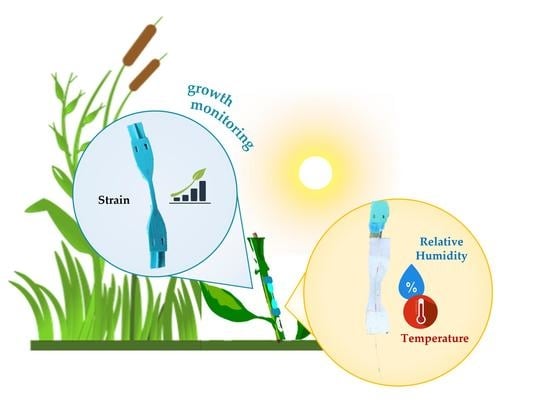Plant Wearable Sensors Based on FBG Technology for Growth and Microclimate Monitoring
Abstract
:1. Introduction
2. The FBG-Based Plant Wearables: Design, Fabrication, and Working Principles
- a dumbbell-shaped flexible sensor to be directly attached to the plant stem for monitoring its growth via ε sensing;
- an environmental sensor consisting of a chitosan (CH)-coated FBG sensor for RH monitoring;
- an environmental sensor consisting of a bare FBG for T monitoring.
2.1. The Plant Wearable Sensor for Growth Monitoring
- the FBG sensor is placed inside the mold;
- the silicone mixture is prepared: Dragon Skin™ 20 silicone part A and part B are equal weight mixed and then vacuum degassed to remove the trapped air bubbles;
- the mixture is poured in the mold to cover the FBG sensor and the curing process starts. After 4 h at room temperature, the plant wearable sensor is ready for use.
2.2. The Environmental Plant Wearable Sensors for Microclimate Monitoring
3. Metrological Characterization of the Plant Wearable Sensors
3.1. Strain Sensitivity of the Dumbbell-Shaped Flexible Sensor
3.2. Relative Humidity Sensitivity
4. Feasibility Assessment of the Plant Wearable Sensors
4.1. Experimental Setup and Protocol
4.1.1. The Growth Chamber Acquisition
4.1.2. The Outdoor In-Field Acquisition
4.2. Data Analysis and Results
4.2.1. The Growth Chamber Acquisition
4.2.2. The Outdoor In-Field Acquisition
5. Discussion
6. Conclusions
Author Contributions
Funding
Institutional Review Board Statement
Informed Consent Statement
Data Availability Statement
Conflicts of Interest
References
- Döring, T.F.; Pautasso, M.; Finckh, M.R.; Wolfe, M.S. Concepts of plant health—Reviewing and challenging the foundations of plant protection. Plant Pathol. 2012, 61, 1–15. [Google Scholar] [CrossRef]
- Rizzo, D.M.; Lichtveld, M.; Mazet, J.A.K.; Togami, E.; Miller, S.A. Plant health and its effects on food safety and security in a One Health framework: Four case studies. One Health Outlook 2021, 3, 1–9. [Google Scholar] [CrossRef] [PubMed]
- Manuscript, A. Plant Stress Tolerance. NIH Public Access 2010, 639, 1–14. [Google Scholar]
- Körner, O.; Challa, H. Process-based humidity control regime for greenhouse crops. Comput. Electron. Agric. 2003, 39, 173–192. [Google Scholar] [CrossRef]
- Pandey, P.; Irulappan, V.; Bagavathiannan, M.V.; Senthil-Kumar, M. Impact of combined abiotic and biotic stresses on plant growth and avenues for crop improvement by exploiting physio-morphological traits. Front. Plant Sci. 2017, 8, 537. [Google Scholar] [CrossRef] [Green Version]
- Wood, K.A.; Stillman, R.A.; Clarke, R.T.; Daunt, F.; O’Hare, M.T. Understanding Plant Community Responses to Combinations of Biotic and Abiotic Factors in Different Phases of the Plant Growth Cycle. PLoS ONE 2012, 7, e49824. [Google Scholar] [CrossRef] [Green Version]
- Lipiec, J.; Doussan, C.; Nosalewicz, A.; Kondracka, K. Effect of drought and heat stresses on plant growth and yield: A review. Int. Agrophys. 2013, 27, 463–477. [Google Scholar] [CrossRef]
- FAO International Year of Plant Health 2020 FAO Food and Agriculture Organization of the United Nations. Available online: http://www.fao.org/plant-health-2020/home/en/ (accessed on 30 July 2021).
- Strange, R.N.; Scott, P.R. Plant disease: A threat to global food security. Annu. Rev. Phytopathol. 2005, 43, 83–116. [Google Scholar] [CrossRef]
- Rosegrant, M.W.; Cline, S.A. Global Food Security: Challenges and Policies. Science 2003, 302, 1917–1919. [Google Scholar] [CrossRef] [Green Version]
- Anderson, K.; Ryan, B.; Sonntag, W.; Kavvada, A.; Friedl, L. Earth observation in service of the 2030 Agenda for Sustainable Development. Geo-Spat. Inf. Sci. 2017, 20, 77–96. [Google Scholar] [CrossRef]
- Moysiadis, V.; Sarigiannidis, P.; Vitsas, V.; Khelifi, A. Smart Farming in Europe. Comput. Sci. Rev. 2021, 39, 100345. [Google Scholar] [CrossRef]
- Mulla, D.J. Twenty five years of remote sensing in precision agriculture: Key advances and remaining knowledge gaps. Biosyst. Eng. 2013, 114, 358–371. [Google Scholar] [CrossRef]
- Chai, Y.; Chen, C.; Luo, X.; Zhan, S.; Kim, J.; Luo, J.; Wang, X.; Hu, Z.; Ying, Y.; Liu, X. Cohabiting Plant-Wearable Sensor in situ Monitors Water Transport in Plant. Adv. Sci. 2021, 8, 2003642. [Google Scholar] [CrossRef] [PubMed]
- Viscarra Rossel, R.A.; Behrens, T.; Ben-Dor, E.; Brown, D.J.; Demattê, J.A.M.; Shepherd, K.D.; Shi, Z.; Stenberg, B.; Stevens, A.; Adamchuk, V.; et al. A global spectral library to characterize the world’s soil. Earth-Sci. Rev. 2016, 155, 198–230. [Google Scholar] [CrossRef] [Green Version]
- Zhao, Y.; Gao, S.; Zhu, J.; Li, J.; Xu, H.; Xu, K.; Cheng, H.; Huang, X. Multifunctional Stretchable Sensors for Continuous Monitoring of Long-Term Leaf Physiology and Microclimate. ACS Omega 2019, 4, 9522–9530. [Google Scholar] [CrossRef] [PubMed] [Green Version]
- Gowen, A.A.; O’Donnell, C.P.; Cullen, P.J.; Downey, G.; Frias, J.M. Hyperspectral imaging—An emerging process analytical tool for food quality and safety control. Trends Food Sci. Technol. 2007, 18, 590–598. [Google Scholar] [CrossRef]
- Chen, Y.R.; Chao, K.; Kim, M.S. Machine vision technology for agricultural applications. Comput. Electron. Agric. 2002, 36, 173–191. [Google Scholar] [CrossRef] [Green Version]
- Geipel, J.; Link, J.; Claupein, W. Combined spectral and spatial modeling of corn yield based on aerial images and crop surface models acquired with an unmanned aircraft system. Remote Sens. 2014, 6, 10335–10355. [Google Scholar] [CrossRef] [Green Version]
- Roper, J.M.; Garcia, J.F.; Tsutsui, H. Emerging Technologies for Monitoring Plant Health In Vivo. ACS Omega 2021, 6, 5101–5107. [Google Scholar] [CrossRef] [PubMed]
- Murr, L.E. Plant growth response in a simulated electric field-environment. Nature 1963, 200, 490–491. [Google Scholar] [CrossRef]
- Billings, W.D. The environmental complex in relation to plant growth and distribution. Q. Rev. Biol. 1952, 27, 251–265. [Google Scholar] [CrossRef]
- Lu, Y.; Xu, K.; Zhang, L.; Deguchi, M.; Shishido, H.; Arie, T.; Pan, R.; Hayashi, A.; Shen, L.; Akita, S.; et al. Multimodal Plant Healthcare Flexible Sensor System. ACS Nano 2020, 14, 10966–10975. [Google Scholar] [CrossRef]
- Tang, W.; Yan, T.; Wang, F.; Yang, J.; Wu, J.; Wang, J.; Yue, T.; Li, Z. Rapid fabrication of wearable carbon nanotube/graphite strain sensor for real-time monitoring of plant growth. Carbon 2019, 147, 295–302. [Google Scholar] [CrossRef]
- Nassar, J.M.; Khan, S.M.; Villalva, D.R.; Nour, M.M.; Almuslem, A.S.; Hussain, M.M. Compliant plant wearables for localized microclimate and plant growth monitoring. NPJ Flex. Electron. 2018, 2, 1–12. [Google Scholar] [CrossRef] [Green Version]
- Yin, H.; Cao, Y.; Marelli, B.; Zeng, X.; Mason, A.J.; Cao, C. Soil Sensors and Plant Wearables for Smart and Precision Agriculture. Adv. Mater. 2021, 33, 2007764. [Google Scholar] [CrossRef] [PubMed]
- Kim, J.J.; Allison, L.K.; Andrew, T.L. Vapor-printed polymer electrodes for long-term, on-demand health monitoring. Sci. Adv. 2019, 5, eaaw0463. [Google Scholar] [CrossRef] [PubMed] [Green Version]
- Hsu, H.H.; Zhang, X.; Xu, K.; Wang, Y.; Wang, Q.; Luo, G.; Xing, M.; Zhong, W. Self-powered and plant-wearable hydrogel as LED power supply and sensor for promoting and monitoring plant growth in smart farming. Chem. Eng. J. 2021, 422, 129499. [Google Scholar] [CrossRef]
- Zhao, F.; He, J.; Li, X.; Bai, Y.; Ying, Y.; Ping, J. Smart plant-wearable biosensor for in-situ pesticide analysis. Biosens. Bioelectron. 2020, 170, 112636. [Google Scholar] [CrossRef] [PubMed]
- Massaroni, C.; Zaltieri, M.; Presti, L.; Nicolò, A.; Tosi, D.; Schena, E. Fiber Bragg grating sensors for cardiorespiratory monitoring: A review. IEEE Sens. J. 2021, 21, 14069–14080. [Google Scholar] [CrossRef]
- Mishra, V.; Singh, N.; Tiwari, U.; Kapur, P. Fiber grating sensors in medicine: Current and emerging applications. Sens. Actuators A Phys. 2011, 167, 279–290. [Google Scholar] [CrossRef]
- Al-Fakih, E.; Osman, N.A.A.; Adikan, F.R.M. The use of fiber bragg grating sensors in biomechanics and rehabilitation applications: The state-of-the-art and ongoing research topics. Sensors 2012, 12, 12890–12926. [Google Scholar] [CrossRef]
- Lo Presti, D.; Massaroni, C.; Jorge Leitao, C.S.; De Fatima Domingues, M.; Sypabekova, M.; Barrera, D.; Floris, I.; Massari, L.; Oddo, C.M.; Sales, S.; et al. Fiber bragg gratings for medical applications and future challenges: A review. IEEE Access 2020, 8, 156863–156888. [Google Scholar] [CrossRef]
- Lo Presti, D.; Massaroni, C.; D’Abbraccio, J.; Massari, L.; Caponero, M.; Longo, U.G.; Formica, D.; Oddo, C.M.; Schena, E. Wearable system based on flexible fbg for respiratory and cardiac monitoring. IEEE Sens. J. 2019, 19, 7391–7398. [Google Scholar] [CrossRef]
- Lo Presti, D.; Dall’orso, S.; Muceli, S.; Arichi, T.; Neumane, S.; Lukens, A.; Sabbadini, R.; Massaroni, C.; Caponero, M.A.; Formica, D.; et al. An fmri compatible smart device for measuring palmar grasping actions in newborns. Sensors 2020, 20, 6040. [Google Scholar] [CrossRef]
- Panopoulou, A.; Loutas, T.; Roulias, D.; Fransen, S.; Kostopoulos, V. Dynamic fiber Bragg gratings based health monitoring system of composite aerospace structures. Acta Astronaut. 2011, 69, 445–457. [Google Scholar] [CrossRef]
- Kahandawa, G.C.; Epaarachchi, J.; Wang, H.; Lau, K.T. Use of FBG sensors for SHM in aerospace structures. Photonic Sens. 2012, 2, 203–214. [Google Scholar] [CrossRef] [Green Version]
- Panopoulou, A.; Roulias, D.; Loutas, T.H.; Kostopoulos, V. Health monitoring of aerospace structures using fibre Bragg gratings combined with advanced signal processing and pattern recognition techniques. Strain 2012, 48, 267–277. [Google Scholar] [CrossRef]
- Xiao, F.; Chen, G.S.; Leroy Hulsey, J. Monitoring bridge dynamic responses using fiber bragg grating tiltmeters. Sensors 2017, 17, 2390. [Google Scholar] [CrossRef] [Green Version]
- Liu, Z.; Liu, P.; Zhou, C.; Huang, Y.; Zhang, L. Structural health monitoring of underground structures in reclamation area using fiber bragg grating sensors. Sensors 2019, 19, 2849. [Google Scholar] [CrossRef] [Green Version]
- Majumder, M.; Gangopadhyay, T.K.; Chakraborty, A.K.; Dasgupta, K.; Bhattacharya, D.K. Fibre Bragg gratings in structural health monitoring-Present status and applications. Sens. Actuators A Phys. 2008, 147, 150–164. [Google Scholar] [CrossRef]
- Shevchenko, Y.; Francis, T.J.; Blair, D.A.D.; Walsh, R.; Derosa, M.C.; Albert, J. In Situ biosensing with a surface plasmon resonance fiber grating aptasensor. Anal. Chem. 2011, 83, 7027–7034. [Google Scholar] [CrossRef] [PubMed]
- Chryssis, A.N.; Saini, S.S.; Lee, S.M.; Yi, H.; Bentley, W.E.; Dagenais, M. Detecting hybridization of DNA by highly sensitive evanescent field etched core fiber Bragg grating sensors. IEEE J. Sel. Top. Quantum Electron. 2005, 11, 864–872. [Google Scholar] [CrossRef]
- Zhao, X.; Dong, M.; Zhang, Y.; Luo, F.; Zhu, L. Simultaneous measurement of strain, temperature and refractive index based on a fiber Bragg grating and an in-line Mach–Zehnder interferometer. Opt. Commun. 2019, 435, 61–67. [Google Scholar] [CrossRef]
- Lo Presti, D.; Massaroni, C.; Piemonte, V.; Saccomandi, P.; D’Amato, R.; Caponero, M.A.; Schena, E. Agar-Coated Fiber Bragg Grating Sensor for Relative Humidity Measurements: Influence of Coating Thickness and Polymer Concentration. IEEE Sens. J. 2019, 19, 3335–3342. [Google Scholar] [CrossRef]
- Lo Presti, D.; Massaroni, C.; Schena, E. Optical Fiber Gratings for Humidity Measurements: A Review. IEEE Sens. J. 2018, 18, 9065–9074. [Google Scholar] [CrossRef]
- Erdogan, T. Fiber grating spectra. J. Light. Technol. 1997, 15, 1277–1294. [Google Scholar] [CrossRef] [Green Version]
- Honarkar, H.; Barikani, M. Applications of biopolymers I: Chitosan. Mon. Fur Chem. 2009, 140, 1403–1420. [Google Scholar] [CrossRef]
- D’amato, R.; Polimadei, A.; Terranova, G.; Caponero, M.A. Humidity sensing by chitosan-coated fibre bragg gratings (Fbg). Sensors 2021, 21, 3348. [Google Scholar] [CrossRef]
- David, N.A.; Wild, P.M.; Djilali, N. Parametric study of a polymer-coated fibre-optic humidity sensor. Meas. Sci. Technol. 2012, 23, 035103. [Google Scholar] [CrossRef]
- Tang, W.; Yan, T.; Ping, J.; Wu, J.; Ying, Y. Rapid Fabrication of Flexible and Stretchable Strain Sensor by Chitosan-Based Water Ink for Plants Growth Monitoring. Adv. Mater. Technol. 2017, 2, 1700021. [Google Scholar] [CrossRef]
- Baskin, T.I.; Jensen, O.E. On the role of stress anisotropy in the growth of stems. J. Exp. Bot. 2013, 64, 4697–4707. [Google Scholar] [CrossRef] [Green Version]
- Bastien, R.; Douady, S.; Moulia, B. A unifying modeling of plant shoot gravitropism with an explicit account of the effects of growth. Front. Plant Sci. 2014, 5, 136. [Google Scholar] [CrossRef] [PubMed] [Green Version]


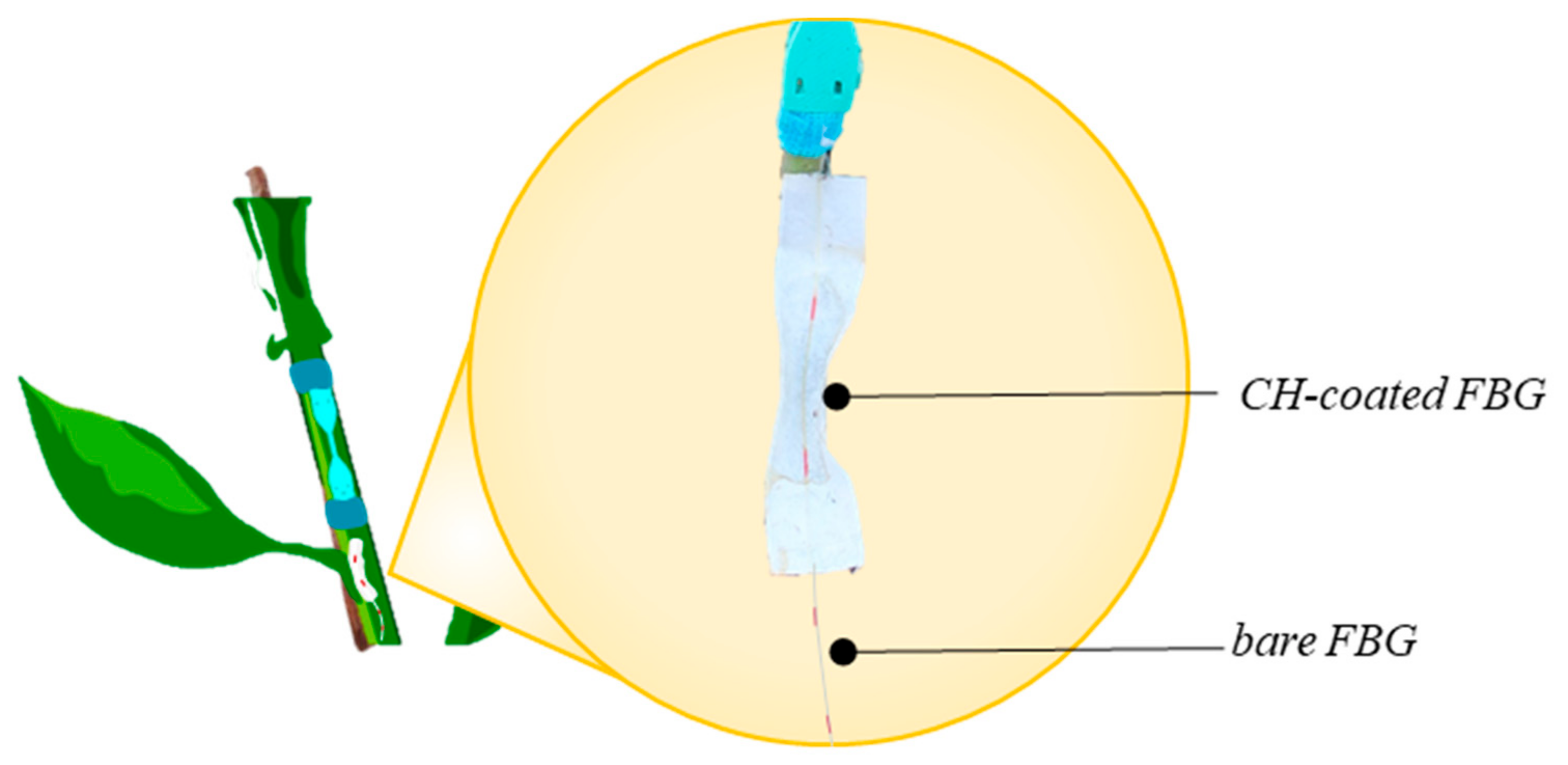





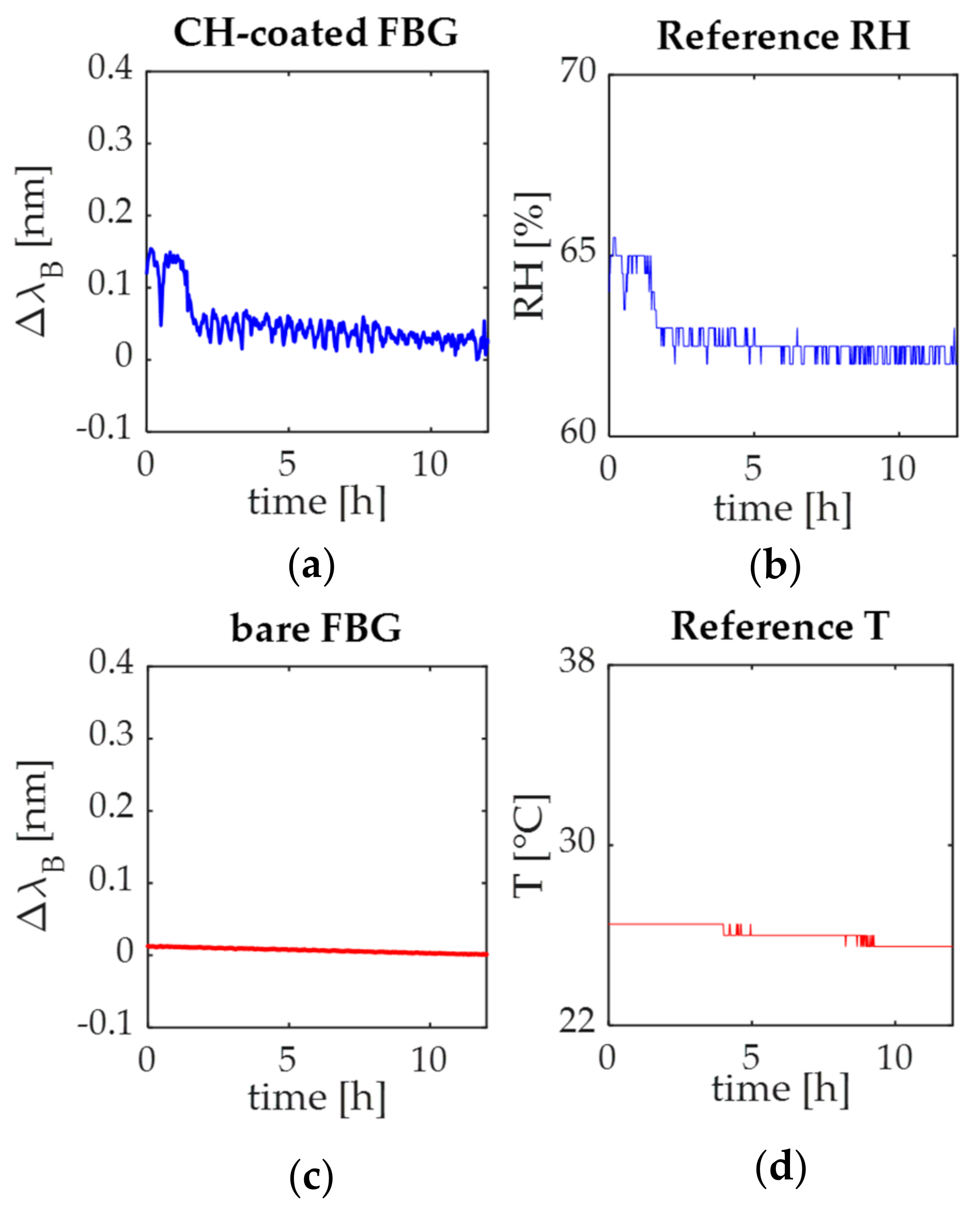
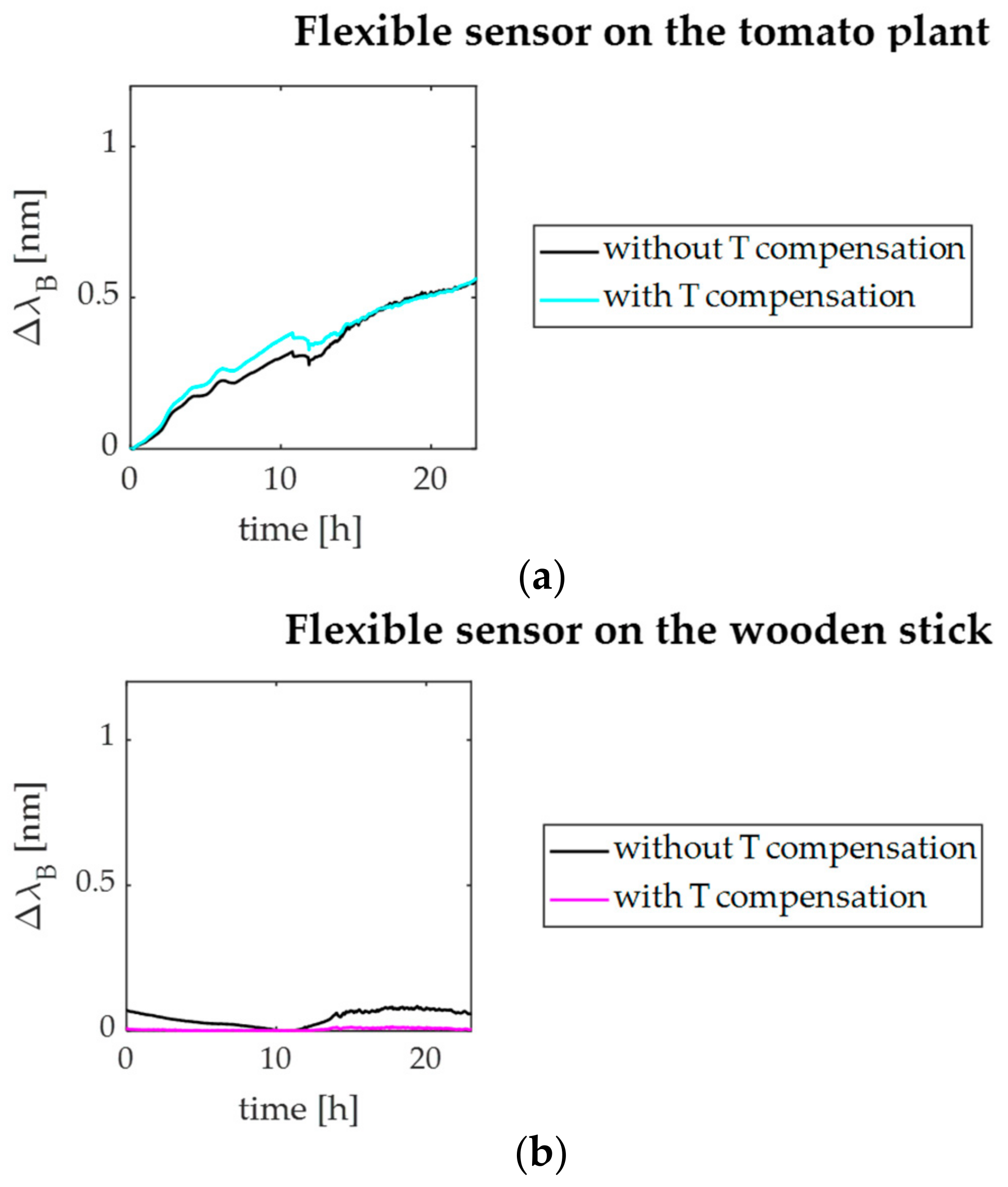
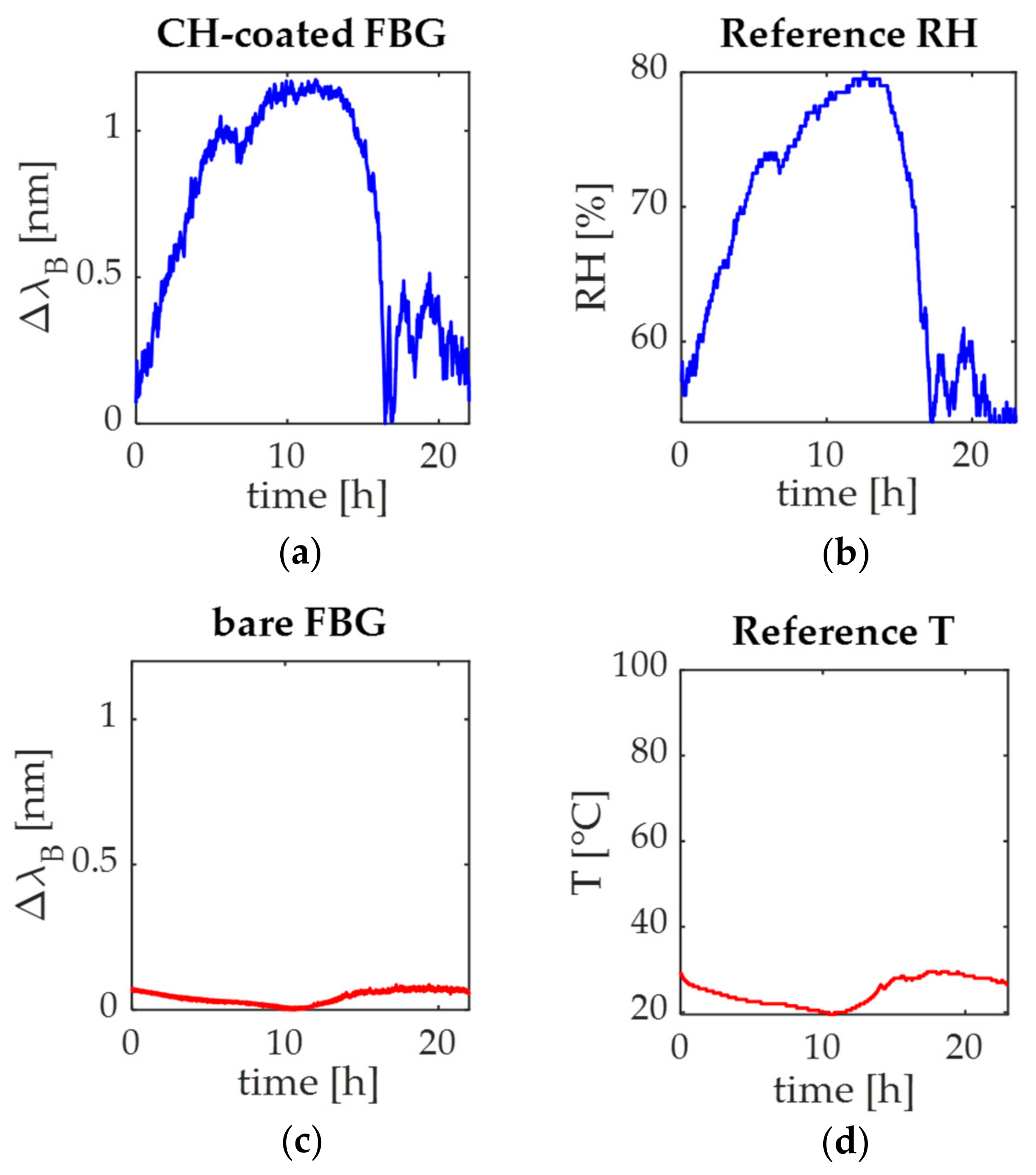
Publisher’s Note: MDPI stays neutral with regard to jurisdictional claims in published maps and institutional affiliations. |
© 2021 by the authors. Licensee MDPI, Basel, Switzerland. This article is an open access article distributed under the terms and conditions of the Creative Commons Attribution (CC BY) license (https://creativecommons.org/licenses/by/4.0/).
Share and Cite
Lo Presti, D.; Cimini, S.; Massaroni, C.; D’Amato, R.; Caponero, M.A.; De Gara, L.; Schena, E. Plant Wearable Sensors Based on FBG Technology for Growth and Microclimate Monitoring. Sensors 2021, 21, 6327. https://doi.org/10.3390/s21196327
Lo Presti D, Cimini S, Massaroni C, D’Amato R, Caponero MA, De Gara L, Schena E. Plant Wearable Sensors Based on FBG Technology for Growth and Microclimate Monitoring. Sensors. 2021; 21(19):6327. https://doi.org/10.3390/s21196327
Chicago/Turabian StyleLo Presti, Daniela, Sara Cimini, Carlo Massaroni, Rosaria D’Amato, Michele Arturo Caponero, Laura De Gara, and Emiliano Schena. 2021. "Plant Wearable Sensors Based on FBG Technology for Growth and Microclimate Monitoring" Sensors 21, no. 19: 6327. https://doi.org/10.3390/s21196327








